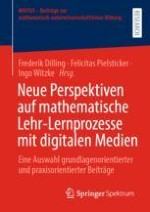2022 | OriginalPaper | Buchkapitel
Zusammenhänge von motivationalen und affektiven Aspekten und digitaler Herzfrequenzmessung bei mathematischer Wissensentwicklung beschreiben – Eine quantitative Studie
verfasst von : Felicitas Pielsticker, Magnus Reifenrath
Erschienen in: Neue Perspektiven auf mathematische Lehr-Lernprozesse mit digitalen Medien
Verlag: Springer Fachmedien Wiesbaden
Aktivieren Sie unsere intelligente Suche, um passende Fachinhalte oder Patente zu finden.
Wählen Sie Textabschnitte aus um mit Künstlicher Intelligenz passenden Patente zu finden. powered by
Markieren Sie Textabschnitte, um KI-gestützt weitere passende Inhalte zu finden. powered by
